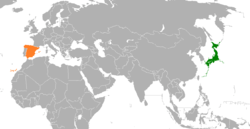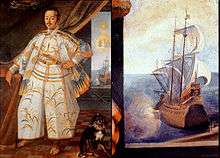Japan–Spain relations
 | |
Japan |
Spain |
|---|---|
Japan–Spain relations refers to the bilateral relations between Japan and Spain. Both nations are members of the Organisation for Economic Co-operation and Development.
History
Early history

The first contact between Japan and Spain occurred in 1549 when Spanish missionary Francis Xavier arrived to Japan. While in Japan, Xavier embarked upon a major evangelizing project and he founded the first Catholic colony in Japan.[1]
In 1565, Spain created the Manila-Acapulco trade route, which was a trade routes between Manila, capital of the Philippines and the Mexican port of Acapulco (both nations under Spanish rule at the time). Through this trade route, Spanish galleons sailed from Acapulco to the Philippines and traded with neighboring countries/territories within the vicinity. Some of those territories were the islands of Japan. In Manila, Japanese trading boats would arrive and bring goods and food to trade with the New Spanish government.[2] From Manila, Spanish vessels would transport the goods back to Acapulco, traverse the Mexican terrain until they reached the port of Veracruz and from there transport the goods onto another Spanish vessel for sail to Spain.
In 1582, a group of Japanese Christian delegates known as the Tenshō embassy left Nagasaki, Japan and traveled on a grand tour of Europe. In 1584, the embassy arrived to Toledo and Madrid where they meet with King Philip II of Spain.[3] In October 1613, the first official Japanese diplomatic mission was sent to New Spain by Masamune Date, a regional strongman. This diplomatic mission was to be known as the Keichō embassy and it was the second diplomatic mission to travel to Europe after the Tenshō embassy. The Japanese ambassador, Hasekura Tsunenaga traveled from Japan to Acapulco and met with the Spanish viceroy Diego Fernández de Córdoba. In Mexico City (the capital of New Spain), Hasekura met with several colonial leaders and offered the New Spanish government free commerce between the New Spanish territories and Japan and asked for a group of Christian missionaries to return to Japan. The diplomatic mission also offered to expel both English and Dutch citizens from the country because both nations were considered at the time to be enemies of the Spanish king. In June 1614, Hasekura left New Spain via Veracruz and continued on his journey to Spain to meet with the Spanish king leaving behind a small delegation. In Spain, Hasekura was baptized a catholic and changed his name to Francisco Felipe Faxicura. Two years later in February 1617, Hasekura/Faxicura returned from Spain to Veracruz and traveled to Mexico City. Before leaving Spain, Hasekura left behind six samurais in the town of Coria del Río where their descendants remain today with the surname of Japón.[4]
In 1618, Hasekura and his diplomatic mission set sail from New Spain and returned to Japan. On arrival, they were confronted with the fact that the country had dramatically changed since their departure in 1613 and that anything related to Christianity had been banned. Hasekura and his delegation had to renounce their adopted religion. Since Hasekura's diplomatic mission to Spain, Japan entered a time of isolation and refused to trade with foreign nations.[2] It wasn't until 12 November 1868 that Japan and Spain officially established diplomatic relations with the signing of the Treaty of Friendship, Commerce and Navigation.[5]
World War II and post war relations
During World War II, Spain initially aligned itself with the Axis powers (although officially neutral during the war). In 1944, General Francisco Franco believed that the Allies may win the war and began to distance Spain from the influence of the Axis powers. Following the lead of some nations, Spain wished to maintain relations with Germany and Italy and cut relations with Japan. Some members of the Spanish government viewed Japan as being "Anti-Christian and Anti-Western".[6] On 17 March 1945, the Spanish government decided to withdraw its protection of Japanese interests in the country. Soon, Japan began suffering setbacks in the Pacific and Spain decided not to pursue further actions against Japan.[6]
After World War II, relations between Japan and Spain improved. In October 1980, Spanish King Juan Carlos I paid an official visit to Japan.[7] In September 1994, Japanese Emperor Akihito paid an official visit to Spain.[8] Since the initial visits, there have been several high level Royal and Governmental visits between leaders of both nations. In 2017, both nations celebrated 150 years of diplomatic relations.[5]
Agreements
Both nations have signed numerous agreements such as a Treaty of Friendship, Commerce and Navigation (1868); Agreement on the Elimination of Tourist Visas (1965); Agreement on Air Services (1980); Agreement on Cultural Cooperation (1982); Agreement on Scientific and Technological Cooperation (2011); Agreement on Exchange and Cooperation in Defense (2014); Agreement on Sports Cooperation (2017); Agreement on Economic and Industrial Cooperation (2017) and an Agreement on Scientific and Investigative Medical Cooperation (2017).[9]
Tourism
Spain is the 5th largest European destination for Japanese tourists with 473,000 Japanese citizens visiting Spain and spending more than €900 million Euros in 2017.[5][10] During the same period, 100,000 Spanish citizens traveled to Japan. There are direct flights between Madrid and Tokyo with Iberia airlines.
Trade
In 2015, trade between Japan and Spain totaled €5.5 billion Euros (729 billion Yen). Japan's main exports to Spain include: Chemical products, machinery and transportation equipment. Spain's exports to Japan include: Transportation equipment and machinery.[11] Japan is Spain's second largest trading partner in Asia and Spain is Japan's sixth largest trading partner within the European Union.[10]
Resident diplomatic missions
- Japan has an embassy in Madrid, a consulate-general in Barcelona and a consulate in Las Palmas.[12]
- Spain has an embassy in Tokyo.[13]
_02.jpg) Embassy of Japan in Madrid
Embassy of Japan in Madrid- Embassy of Spain in Tokyo
See also
References
- ↑ Relations between Japan and Spain
- 1 2 Bilateral relations between Japan and New Spain (Mexico) (in Spanish)
- ↑ Spiritual Saga: The Japanese Mission to Europe, 1582-1590
- ↑ Spain’s Japon clan has reunion to trace its 17th century roots
- 1 2 3 España y Japón celebran 150 años de relaciones diplomáticas (in Spanish)
- 1 2 Franco's Spain and the Japanese Empire
- ↑ Los Reyes inician hoy su primera visita oficial a Japón (in Spanish)
- ↑ El emperador Akihito, de Japón, anuncia él mismo su viaje a España (in Spanish)
- ↑ Spanish Ministry of Foreign Affairs: Japan (in Spanish)
- 1 2 150 años de relaciones diplomáticas entre España y Japón (in Spanish)
- ↑ Japan-Spain Relations (Basic Data)
- ↑ Embassy of Japan in Madrid
- ↑ Embassy of Spain in Tokyo


.svg.png)